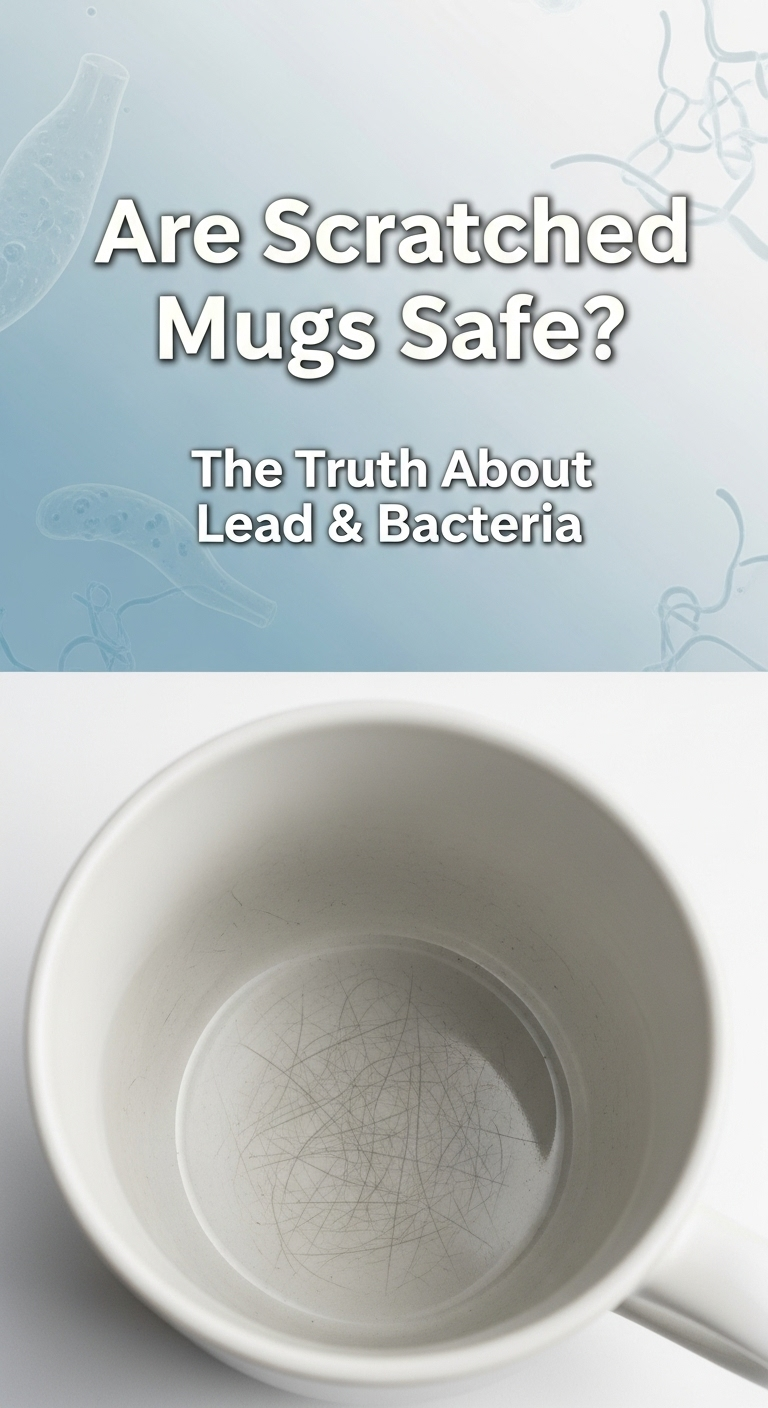As an Amazon Associate CoffeeXplore.com earns from qualifying purchases.
Are Scratched Mugs Safe? The Truth About Lead & Bacteria
Ever looked at your favorite, well-loved coffee mug and wondered if those scratches are more than just cosmetic? You reach for it every morning, but a nagging thought crosses your mind: are scratched coffee mugs safe to drink from? It’s a common question that leaves many coffee lovers uncertain about whether their daily ritual involves hidden dangers like lead or bacteria.
No, scratched ceramic coffee mugs may not be safe, especially if the scratches are deep, the mug is old, or it was cheaply made. The main risks are harmful substances like lead leaching into your drink and bacterial growth in the exposed material.
This guide will provide a definitive answer. We’ll dive into the science behind the risks, show you how to tell the difference between a harmless scuff and a hazardous crack, and give you a clear action plan. By the end, you will know exactly when to clean your mug, when to repurpose it, and when it’s time to say goodbye, ensuring your coffee habit is always a safe one.
Key Facts
- Heavy Metal Leaching: Mugs produced before the 1970s, or those of low quality, may contain lead and cadmium in their glazes. Scratches can allow these toxins to leach into hot and acidic beverages like coffee, posing significant health risks over time.
- Bacterial Hotspots: Deep scratches and cracks break the protective glaze, exposing the porous ceramic underneath. This material can trap moisture and beverage residue, creating an ideal breeding ground for harmful bacteria and mold that is difficult to clean.
- Not All Marks are Damage: Many gray or dark marks inside mugs are not scratches but harmless metal deposits from spoons and other utensils. Evidence suggests these can often be removed with a simple paste of baking soda and water.
- Heat and Acidity Accelerate Risk: The combination of high temperatures and acidity, characteristic of coffee, can significantly increase the rate at which heavy metals like lead leach from a compromised glaze.
- Location Matters: Scratches on the outside of a mug are generally considered cosmetic and do not pose a health risk. The danger lies with damage to the interior, food-contact surfaces of the mug.
Understanding the Damage: Not All Scratches Are Created Equal

Gray marks from spoons are typically just metal deposits on the glaze and are not dangerous. Deep scratches, chips, or cracks that expose the porous ceramic underneath are the primary safety concern. Before you decide to toss your favorite mug, it’s crucial to correctly identify the type of mark you’re dealing with. One is a simple cosmetic issue, while the other is a potential health hazard.
Pro Tip: Before you panic, try the baking soda test mentioned below. You might be surprised to find those scary-looking marks disappear!
The key difference lies in whether the protective glaze has been broken. The glaze is the glassy, non-porous shield that makes a ceramic mug safe and easy to clean. If that shield is intact, you’re in the clear. If it’s compromised, you need to be cautious.
| Feature | Utensil Marks (Safe) | Deep Scratches/Chips (Unsafe) |
|---|---|---|
| Appearance | Fine, gray, or black lines on the surface. Often looks like a pencil drawing. | A physical indentation, crack, or chip in the surface. Can be discolored. |
| Feel | You cannot feel it with your fingernail; the surface is still smooth. | Your fingernail will catch in the groove or on the edge of the chip. |
| Cause | Metal from utensils (spoons, forks) rubbing off and depositing onto the hard glaze. | Impact from being dropped, hit, or scraped by a harder object. |
| Safety | Considered safe. The mark is on top of the protective glaze. | Unsafe. The protective glaze is broken, exposing the porous ceramic. |
| Solution | Can be cleaned off with a gentle abrasive like baking soda. | Cannot be “cleaned.” The mug should be repurposed or discarded. |
The Harmless Marks: Metal Scuffs from Utensils
These marks are usually metal residue, not damage to the mug itself, and can often be cleaned off with a paste of baking soda and water.
If you’ve ever stirred your coffee and seen faint gray lines appear over time, you’ve witnessed this common phenomenon. It’s not the mug being scratched; it’s the mug scratching your spoon! The hard ceramic glaze scrapes off microscopic particles of metal from your cutlery, leaving a deposit behind. As a Brit, pretty much every loved mug in a household looks like this. It’s a sign of a well-used cup, not a dangerous one.

Here’s how to easily remove them:
1. Put a small amount of baking soda into the bottom of the mug.
2. Add just enough water to create a thick paste.
3. Using your fingers or a soft cloth, scrub the paste firmly onto the metal marks.
4. Rinse the mug thoroughly. The marks should be gone or significantly faded.
Did it work? This simple trick saves countless mugs from being thrown away needlessly!
The Real Danger: Deep Scratches, Chips, and Cracks
When a scratch is deep enough to break the glaze, it exposes the porous ceramic, creating a risk for both chemical leaching and bacterial growth.
This is the type of damage you need to worry about. Unlike a surface scuff, a deep crack or scratch is a structural failure of the mug’s protective layer. Run your fingernail across the mark. If it catches, you’re likely dealing with a deep scratch that needs closer attention. This breach of the glaze opens a pathway to the raw, absorbent clay underneath.
The risks of using a mug with this type of damage include:
* Chemical Leaching: Harmful substances from the glaze or clay can seep into your drink.
* Bacterial Harbor: The exposed porous ceramic acts like a sponge, trapping bacteria and mold.
* Difficult Cleaning: It’s nearly impossible to fully clean and sanitize the tiny crevices of a crack.
* Weakened Structure: A small crack can easily grow larger with temperature changes (like pouring in hot coffee), leading to the mug breaking unexpectedly.

The Hidden Health Risks of Damaged Mugs
Damaged mugs can leach toxic heavy metals like lead and cadmium from old or low-quality glazes into hot drinks and can also harbor harmful bacteria and mold in hard-to-clean cracks.
The reason are scratched coffee mugs safe is such a critical question is that the dangers are often invisible. You can’t see lead leaching into your morning brew, nor can you spot the bacteria colonizing a hairline fracture. Understanding these two primary risks is key to making a safe decision.
Quick Fact: Mugs made before 1970 are at a higher risk for lead, as this was before the FDA began rigorous testing.
- Heavy Metal and Chemical Leaching
- Lead and Cadmium: Historically used in ceramic glazes for bright colors and a durable finish. If the glaze is scratched, these toxic heavy metals can dissolve into hot, acidic liquids like coffee or tea. Chronic exposure is linked to kidney damage, nerve damage, and other serious health issues.
- Arsenic: Another toxic metal that can be present in some glazes. Ingestion over time can lead to severe health problems.
- BPA: While more common in plastics, some ceramic mugs may have linings containing BPA. Scratches can accelerate the leaching of this chemical, which is linked to hormonal imbalances.
- Bacterial and Mold Growth
- Porous Havens: The exposed ceramic underneath a crack is absorbent. It soaks up a tiny amount of your drink each time you use it.
- Breeding Ground: This trapped moisture and nutrient residue creates the perfect environment for bacteria and mold to flourish, protected from regular washing.
Risk 1: Leaching of Lead, Cadmium, and Other Toxins
Lead and cadmium, historically used in glazes for color and shine, can leach from scratches into hot, acidic drinks like coffee, posing a serious health risk, especially with older mugs.
The vibrant reds, oranges, and yellows on many older or imported mugs often owe their brilliance to lead-based compounds in the glaze. While perfectly safe when the glaze is intact, a scratch acts like an open door. The combination of heat from your coffee and its natural acidity works to dissolve these heavy metals, allowing you to ingest them with every sip.
Warning: Be especially cautious with vintage mugs (made before the 1970s), antique china, or brightly-colored ceramics from regions with less strict regulations. The FDA began regulating lead in ceramicware around 1970, but older items or those made for decorative purposes may contain hazardous levels.
Is that beautiful vintage mug from a flea market worth the potential risk? Unless you can verify it is lead-free, it’s safest to use it for decoration only.
Risk 2: Bacterial and Mold Growth
The porous material under a scratch can trap moisture and beverage residue, creating an ideal breeding ground for bacteria and mold that is difficult to remove.
Think of a crack in a mug like a crack in a sidewalk—it’s amazing what can start growing in there if it’s not sealed. Even if your mug looks clean after washing, a hairline fracture can harbor a colony of microorganisms. A practical, experience-based insight is that even high-temperature dishwashers can’t effectively force water and soap into the microscopic “nooks and crannies” of a crack to sanitize it properly.
Here’s the simple, dangerous progression:
1. The protective glaze is cracked or chipped.
2. The absorbent, porous ceramic underneath is exposed.
3. Moisture, milk, sugar, and coffee residue get trapped inside the crack.
4. This protected, nutrient-rich environment allows bacteria and mold to grow and multiply.
Your Action Plan: When to Clean, Repurpose, or Throw Out a Mug
For minor utensil marks, clean the mug. For deep scratches, cracks, or chips on the inside, it’s safest to stop using it for drinks and either repurpose it or throw it away.
Now that you can identify the different types of damage and understand the risks, you need a clear framework for what to do next. This simple decision guide will help you confidently assess your mug collection and ensure every cup you use is safe.
| Mug Condition | Recommended Action | Why? |
|---|---|---|
| Fine Gray/Black Lines (Utensil Marks) | Clean It | These are harmless metal deposits on top of the glaze. A good scrub with baking soda paste will remove them. |
| Deep Scratch/Crack Inside or on Rim | Repurpose or Discard | The protective glaze is broken, posing a risk of leaching and bacterial growth. It is no longer food-safe. |
| Chip on the Rim or Inside | Repurpose or Discard | A chip is a significant break in the glaze and creates a sharp edge and a haven for bacteria. It is not safe for drinking. |
| Crack on the Outside Only | Use with Caution | If the crack doesn’t go through to the inside, it’s likely safe. However, it has weakened the mug, which could break from thermal shock. |
| Staining (Tea/Coffee) | Clean It | Staining is a cosmetic issue and does not mean the mug is unsafe. A good cleaning should remove it. |
For mugs that are no longer safe to drink from, don’t just throw them away! A cherished mug can find a second life as a pen holder on your desk, a small planter for succulents, or a place to store loose change. This is a safe, practical, and non-wasteful approach.
To avoid these issues in the future and ensure you are making the safest choice, consider using a home testing kit to check for lead, especially on older mugs you love.
FAQs About Scratched Mug Safety
Here are answers to some of the most common questions people have when they ask, are scratched coffee mugs safe?
How can you tell if a mug has lead in it?
You can use a home lead-testing kit, but for accurate results, especially with a cherished or vintage mug, sending it to a certified laboratory is the most reliable option.
* Home Lead Kits: Available at hardware stores, these kits involve a swab that changes color in the presence of lead. However, well-established research indicates they can sometimes produce false negatives, meaning they might not detect lead even when it’s there.
* Lab Testing: The most accurate method. If you have a valuable or sentimental piece you wish to use, a certified lab can give you a definitive answer on its composition and safety.
When should you throw out coffee mugs?
You should throw out or repurpose a coffee mug when it has cracks, chips on the rim or interior, or deep scratches that you can feel with a fingernail, as these compromise its safety. Any break in the interior glaze makes the mug unsuitable for contact with food and drinks. It’s better to be safe and find a new use for it or discard it.
Are scratches on the outside of a mug dangerous?
Generally, no. Scratches on the outside of a mug that do not penetrate through to the inside are a cosmetic issue and do not pose a health risk for drinking. The primary concern is always the integrity of the food-contact surface. As long as the inside is smooth and uncracked, an external scratch is not a danger.
Is it safe to repair a cracked mug with glue?
Even if you use a “food-safe” epoxy, most repairs are best for decorative purposes only. It is not recommended to drink from a previously broken and glued mug, as the seal may not be perfect or durable. Heat and washing can degrade the bond over time, and it’s nearly impossible to guarantee that no small gaps remain where bacteria could grow.
What are the safest materials for coffee mugs?
The safest mugs are typically made from glass, porcelain, or high-quality stoneware with a clearly labeled “lead-free” and “food-safe” glaze on all food-contact surfaces.
* Glass: Inert and non-porous, glass does not leach chemicals and won’t get utensil marks.
* Porcelain and Stoneware: When made by a reputable manufacturer with lead-free glaze, these are excellent and durable choices.
* Stainless Steel: Food-grade stainless steel is another very safe and incredibly durable option.
Final Summary: Key Takeaways for Safe Sipping
The question “are scratched coffee mugs safe” is nuanced, but the answer is clear once you know what to look for. Your daily coffee ritual should be a source of comfort, not concern. By understanding the difference between a harmless scuff and a dangerous crack, you’ve empowered yourself to make an informed decision about every mug in your cabinet.
This guide has shown you that while many marks are merely cosmetic, true damage to a mug’s glaze can pose real health risks from chemical leaching and bacterial growth. The safety of your mug depends entirely on the integrity of its interior surface.
- Inspect First: Always check if a mark is a surface scuff or a deep crack. Use your fingernail—if it catches, be cautious.
- Know the Risks: The primary dangers are lead/cadmium leaching from old or cheap mugs and bacterial growth in porous cracks.
- When in Doubt, Repurpose: If a mug has cracks or chips on the inside, retire it from drink duty. Turn it into a pen holder or planter.
- Buy Smart: For new mugs, choose reputable brands and look for “lead-free” and “food-safe” labels. Materials like glass and high-quality porcelain are excellent choices.
Go take a look at your mug collection. With this knowledge, you can now confidently decide what’s safe to keep in your daily coffee ritual.
Last update on 2025-12-05 / Affiliate links / Images from Amazon Product Advertising API

